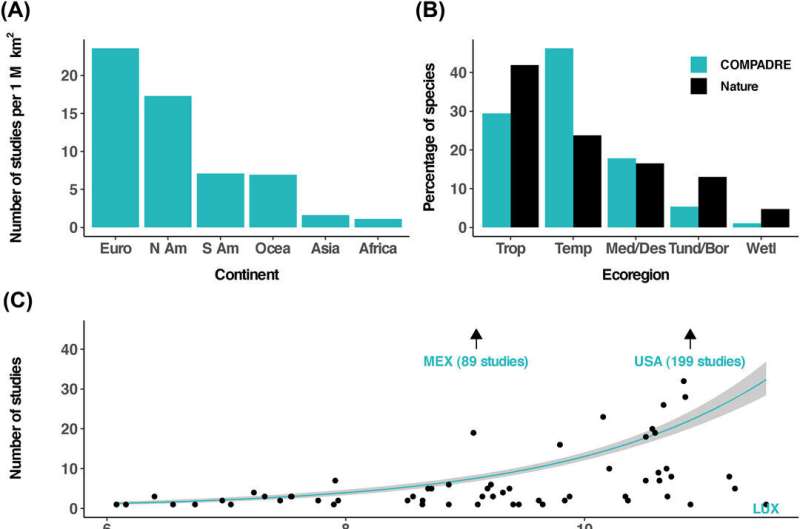This article has been reviewed according to Science X's editorial process and policies. Editors have highlighted the following attributes while ensuring the content's credibility:
fact-checked
proofread
How wealthy countries' research skews our knowledge of plants

More extreme weather and large variations in temperature and precipitation: Climate change affects not only humans and animals but also plants. They, too, face significant challenges, and there is increasing interest in creating climate models to calculate how the world´s plants will respond to a changing climate.
To be able to create such models, it is valuable to know how individual plant populations have fared over time with fluctuations in, for example, temperature and precipitation. However, archives and databases do not hold information about all plants.
There is an overrepresentation of plants growing in temperate regions of Europe and North America. Data on those account for approximately 75% of available scientific data on the world's plants. In contrast, plants from tropical regions are relatively under-studied.
Examples of well-studied plants are the Common Cowslip (Primula veris), which grows in temperate regions of Europe and Asia, and the Pitcher´s Thistle (Cirsium pitcheri), a thistle that is native to North America.
"Imagine you're a policy-maker trying to decide how to understand how plant species will respond to climate change. If your data are skewed, you're essentially working with an incomplete guidebook," warns Owen Jones, lead author of a new study, that reveals critical gaps in current plant demographic research. Owen Jones is an associate professor at Department of Biology, University of Southern Denmark.
The other authors are Gesa Römer (University of Southern Denmark), Johan Dahlgren (University of Southern Denmark), Roberto Salguero-Gómez (University of Oxford), and Iain M. Stott (University of Lincoln). The study is published in the journal Oikos and based on an analysis of plant data from the COMPADRE Plant Matrix Database, which contains data on almost 800 plant species.
"Our current understanding of plant ecology may not be as robust as previously thought," says Owen Jones.
"Wealthy countries are disproportionately well represented in plant studies. And since many researchers study plants that are easy for them to access, they often end up studying plants in the wealthy countries where they live," says the study's co-author Gesa Römer, a recent Ph.D. graduate of SDU.
There are, of course, exceptions: In Panama, the Smithsonian Tropical Research Institute has been describing and studying tropical animals and plants throughout the country since 1910.
The authors point out that other factors also drive the skew:
- Practically, it is easier to study a plant that is easy to access. Therefore, there is little data, for example, on epiphytes; plants that grow high up in the tree canopies and of which there are many species.
- Research projects rarely last more than a few years—four years if you are lucky. That is too short a time to study how a plant population reacts to changing climate.
- If you do not publish your results in the same language, they become difficult to access for some. While the majority of the scientific community publishes in English, many results are still published in, for example, Chinese and Russian.
"These gaps in data have critical implications. Our findings should serve as a call for the scientific community to target these understudied regions and types of plants. Understanding plant demography can guide conservation when environments are rapidly changing", says co-author Johan Dahlgren, also from the Department of Biology, University of Southern Denmark.
More information: Gesa Römer et al, Plant demographic knowledge is biased towards short‐term studies of temperate‐region herbaceous perennials, Oikos (2023). DOI: 10.1111/oik.10250
Provided by University of Southern Denmark




















